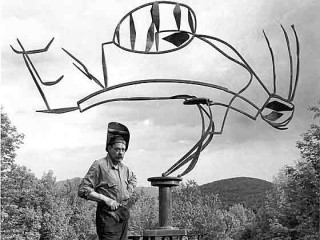
David Smith (sculptor) biography
Date of birth : 1906-03-09
Date of death : 1965-05-23
Birthplace : Decatur, Indiana
Nationality : American
Category : Famous Figures
Last modified : 2011-02-12
Credited as : Artist sculptor, and painter, Royal Bird, Reliquary House
David Smith, American sculptor and painter, pioneered in exploiting welded, openwork metal sculpture. His art was very influential, and he was one of the most significant American artists during the 1950s.
David Smith was born in Decatur, Ind. The family moved to Paulding, Ohio, in 1921. In 1923 Smith studied art through a correspondence school, and the following year he matriculated for a year at Ohio University. During the summers he worked as a welder and riveter at the Studebaker plant in South Bend, Ind. He also took courses at Notre Dame University and at George Washington University. He entered the Art Students League in New York City in 1927 to study painting with John Sloan; that year he married Dorothy Dehner. The next year he studied privately with the Czech painter Jan Matulka, who introduced him to modern painting and sculpture. To support himself, Smith worked part time as a taxi driver, seaman, carpenter, and salesman. In 1929 he bought an old farm in Bolton Landing, N.Y., and set up the studio he used for the rest of his life.
Smith became acquainted with many artists who worked abstractly, and they encouraged him to work in that style. In 1932 he made his first sculptures by attaching stray objects to paintings. On a trip to the Virgin Islands he used coral in his constructions. It was after seeing photographs of Pablo Picasso's metal constructions, however, that he turned wholeheartedly to sculpture. From 1934 to 1940 Smith rented studio space at the Terminal Iron Works in Brooklyn. He would frequently include pieces of "junk" metal in his sculptures. He welded slender lengths of metal strip to circumscribe space in a calligraphic fashion. It was as if Smith were recasting in metal a synthetic cubist painting. A characteristic sculpture of this period is Aerial Construction (1936).
Between 1937 and 1940 Smith struck bronze medals, which he called Medals of Dishonor, to attack war propaganda, munition makers, bacterial warfare, prostitution, and other social ills. The all-important imagery was borrowed from newspapers, magazines, textbooks on medicine, as well as from Old Masters Francisco Goya, Hieronymus Bosch, Pieter Brueghel, and others. In 1938 Smith had his first one-man show. The next year he executed Structure of Arches, a large abstract piece constructed mostly of steel, in which he used arc welding for the first time. In 1940 he made Bolton Landing his permanent residence and supported himself by working part time for the American Locomotive Company in Schenectady, N.Y. After 1944, however, he concentrated on sculpture except for several short-term appointments as a teacher at Sarah Lawrence College, the University of Arkansas, Indiana University, and the University of Mississippi. In 1950 he received a fellowship from the Guggenheim Foundation.
In the late 1940s and early 1950s Smith was still evolving a personal style, still searching for and absorbing influences. Reliquary House (1945) is reminiscent of Alberto Giacometti's surrealist sculptures. Royal Bird (1948) was inspired by a skeleton of a prehistoric bird Smith had seen in the Museum of Natural History in New York; he may have known the influential Spectre of Kitty Hawk, a brazed, welded, hammered steel sculpture by Theodore Roszak executed in 1946. The Letter (1950), Twenty-four Y's (1950), and Hudson River Landscape (1951) are highly original works whose imagery is based on the American scene. They are linear and calligraphic in conception. Slender metal strips form an elegant tangle and appear animated as they gesture in turns, bends, thrusts, and counterthrusts. Within the framework of the tangle, relatively self-contained units appear as if suspended. Not infrequently, they suggest arcane hieroglyphs or quasi-semantical designs. He used color in some works which may have been influenced by his friendship with painters such as Robert Motherwell and Kenneth Noland.
Smith's sculpture became better known in the late 1950s. The Museum of Modern Art gave him a one-man show in 1957. He had two other important one-man shows in New York City—at French and Company in 1959 and at the Otto Gerson Gallery in 1961. In 1962 he was commissioned to make 26 sculptures for the Festival of Two Worlds at Spoleto, and went to went to Italy to execute them. During the 1960s he favored larger forms at the expense of the linear. He made works in series such as Tank Totem, Agricola, Cubi, Menand, and Zig. In Cubi XXVII (1965), one of three monumental polished stainless steel "gates," Smith retained the openness and shifting rhythms of his earlier linear sculptures but composed the work by welding together cubic shapes and a cylinder. These have gleaming surfaces buffed to form shifting patterns reminiscent of frost on a windowpane. This work exemplifies Smith's openness to fresh ideas and the constant evolution of his art and his inventiveness.
In 1952 Smith had divorced his first wife, and the following year he married Jean Treas, with whom he had two daughters. The second marriage was dissolved in 1961. On April 23, 1965, Smith died in Albany, N.Y., from injuries sustained in an automobile accident. There have been several exhibitions since his death; the most extensive was in 1969 at the Solomon R. Guggenheim Museum in New York City.
















